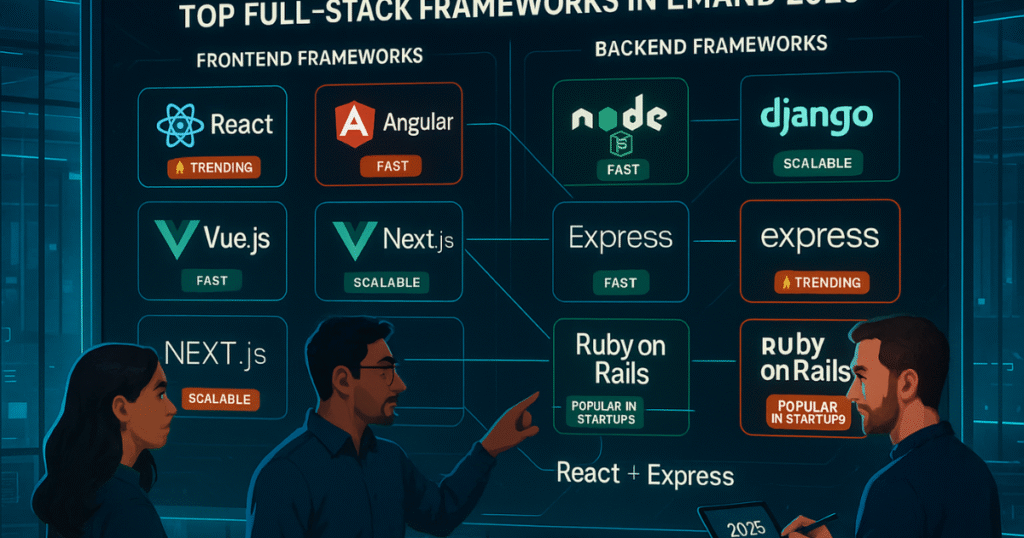Exclusive digital marketing services, 100% Satisfaction, and Money Back Guarantee! Learn More
As the digital landscape evolves, selecting the right technology stack becomes a key strategic decision. The Most In-Demand Full-Stack Frameworks (Frontend + Backend) in 2025 are shaping how developers build scalable, maintainable, and efficient applications. With user expectations rising and business goals becoming more complex, choosing the best frameworks is crucial.
In this article, we explore the top frameworks for full-stack developers, giving insights into what’s trending in 2025. From frontend responsiveness to backend performance, The Most In-Demand Full-Stack Frameworks (Frontend + Backend) help modern developers deliver full-featured applications faster and smarter.
Overview of Popular Full-Stack Frameworks in 2025
The year 2025 sees the continued rise of popular full-stack frameworks like MERN, MEVN, and Django + React combos. These modern web development frameworks combine speed, security, and scalability, making them the top choices for agile development teams. The growing reliance on JavaScript-based stacks like MERN (MongoDB, Express, React, Node.js) showcases how the industry is embracing unified development environments.
What makes these most used full-stack technologies valuable is their ability to streamline frontend-backend integration. Developers can work seamlessly across the stack, reducing handoff issues and increasing efficiency. These frameworks also align well with microservices and cloud-native applications, enabling scalable deployment in production environments.
Choosing the right framework means balancing community support, available libraries, documentation, and integration features. With these options, teams can build MVPs quickly and scale them without complete rewrites.
Top Frontend Frameworks for Developers
The best frontend frameworks for developers in 2025 include React, Vue.js, and Angular. React remains the go-to for component-based architecture and its massive ecosystem. Vue.js continues to grow among beginners and teams seeking lightweight, reactive programming capabilities. Angular is still favored by enterprises for its opinionated structure and built-in tooling.
Many of these are full-stack JavaScript frameworks when paired with Node.js, making them perfect for seamless development. These frameworks offer virtual DOM rendering, excellent state management libraries, and robust routing features, critical for building dynamic, interactive web apps.
Leading Backend Frameworks in Full-Stack Development
When it comes to the top backend frameworks for full-stack development, Node.js with Express tops the list due to its asynchronous performance and alignment with JavaScript frontend frameworks. Django, built in Python, is another favorite for rapid development, built-in admin tools, and robust security.
Ruby on Rails offers convention over configuration benefits and is known for its developer-friendly syntax. Spring Boot (Java) is widely used in enterprise applications due to its modularity and built-in tools for creating RESTful APIs and server-side rendering. These scalable full-stack frameworks manage business logic, APIs, and database communication efficiently.
Comparing Frontend and Backend Frameworks: Pros and Cons
A frontend and backend framework comparison reveals distinct trade-offs. Frontend frameworks like React and Vue offer rapid UI development, high interactivity, and ease of learning. However, managing state in large applications can be complex. Backend frameworks like Django or Spring Boot are powerful for business logic and database interaction but often have steeper learning curves.
Full-stack framework pros and cons depend on project goals. For instance, Node.js offers speed and uniform language use but may lack robust type safety. Django provides security and simplicity but could be restrictive for some custom use cases. Teams must weigh performance, community support, and project scale when choosing.
Trending Full-Stack Development Tools and Technologies
In 2025, trending full-stack development tools include Docker for containerization, GitHub Actions and Jenkins for CI/CD, and Jest and Cypress for testing. These tools complement full-stack frameworks by automating deployment, enhancing code quality, and supporting DevOps practices.
A modern developer’s workflow isn’t complete without integration tools. Cloud platforms like AWS, Netlify, and Vercel enable quick deployment and scalability. Full-stack teams rely on these tools to ensure smooth, automated pipelines and continuous delivery.
How Choosing the Right Full-Stack Framework Supports Your Website Development Goals
Choosing the right framework directly affects your ability to meet timelines, scale efficiently, and maintain codebases long-term. Frameworks should match your project’s architecture, team expertise, and client expectations.
Selecting the right frameworks is critical when offering professional website development services that meet client expectations. Tailored framework choices are especially vital in custom website development services, where each project has unique scalability, performance, and security needs.
Conclusion
In summary, the frontend and backend frameworks you choose have a profound impact on your application’s success. The tools mentioned here are leading the industry in performance, ease of use, and community support.
Staying current with The Most In-Demand Full-Stack Frameworks (Frontend + Backend) in 2025 ensures you build future-ready applications and stay competitive as a full-stack developer.
For additional insights, don’t forget to explore our custom website development services to see how modern frameworks are used in real-world projects.
